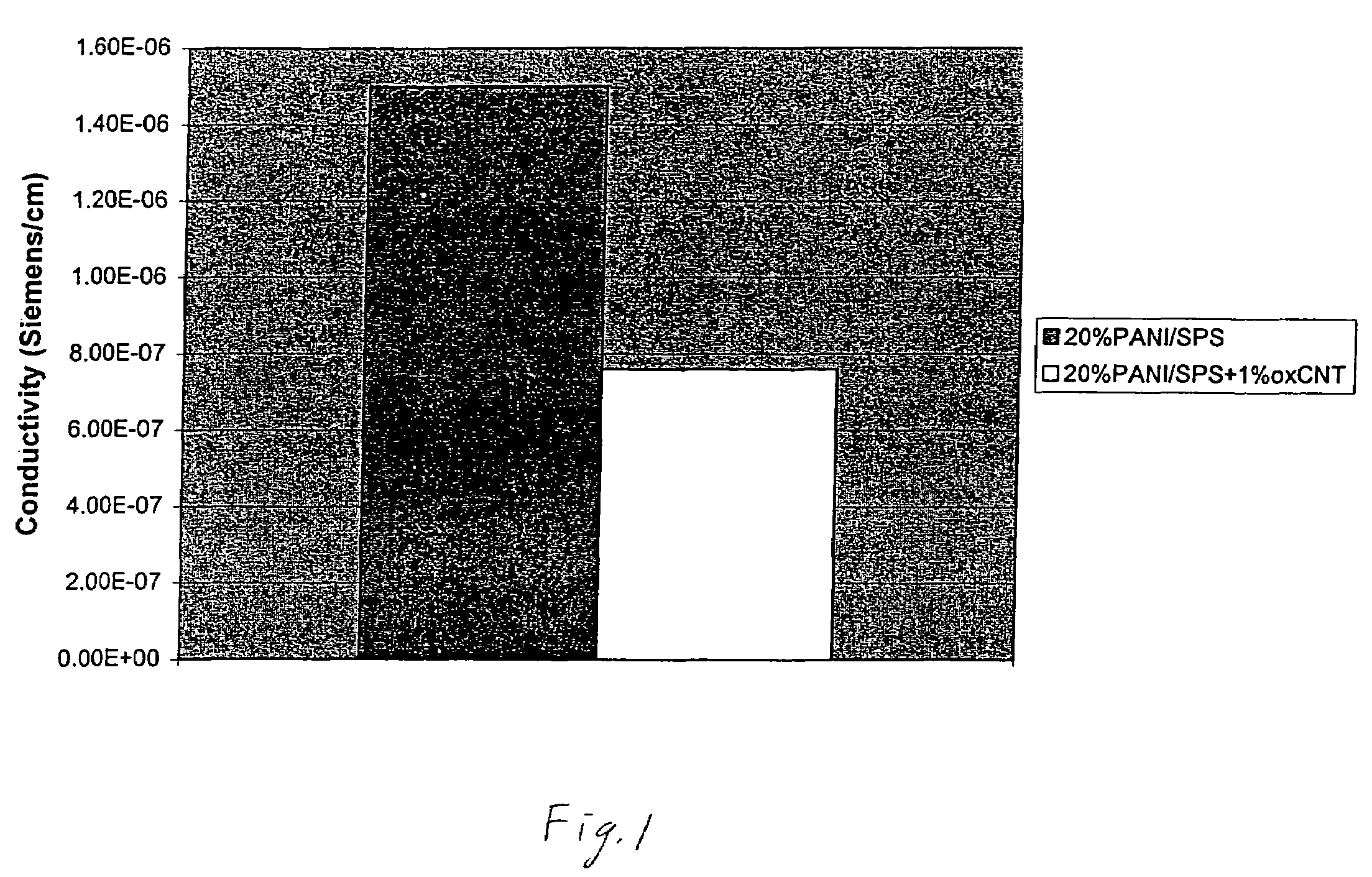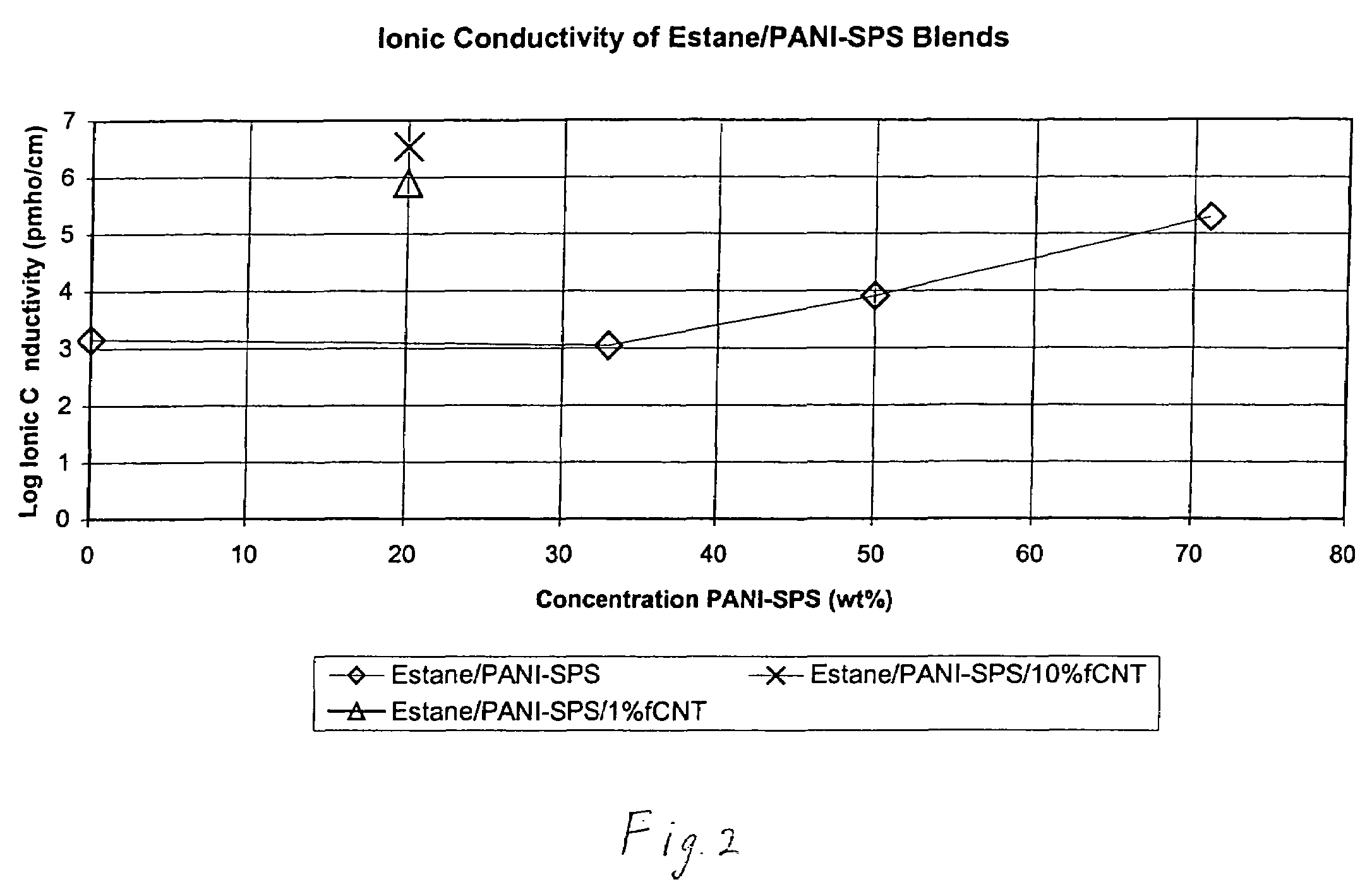[0007]It is therefore a primary object of this invention to provide conductive (electrical, ionic, and photoelectric) membrane articles that are lightweight and porous, yet have
high surface area and are mechanically tough. Such articles can also be fabricated on flexible substrates, such as textiles.
[0010]The invention describes new electrospun conducting polymer membranes and composites that have
high surface areas and are lightweight, tunable and active (electrically, chemically and optically). A purpose of this invention is to develop a new technique to process conducting polymers into useful and more efficient architectures for applications including but not limited to, ionic and electrical
conductivity, photovoltaic devices, electrostatic dissipation, chemical sensing,
corrosion protection,
electromagnetic interference shielding and
radar attenuation. Another purpose of this invention is to improve the
electrospinning process in general, as addition of just a small amount of soluble conducting polymer to the polymer solutions used for
spinning (known in the art as “spin dopes”) improves
fiber formation and morphology without imparting undesired effects to the final membrane. In this invention, conducting polymers (from organic or
aqueous solution or as
solid dispersions) are added directly into a spin dope mixture and applied to various surfaces, including but not limited to metals, semiconductors, glass and textiles, or processed as stand alone membranes, using
electro spinning technologies.
[0011]The conducting polymer membranes of the invention have high surface areas and are lightweight, porous and permeable to vapor. These features are unique in the design and production of conductive thin films: the
high surface area of the
electrospun fiber enhances
exposure of photo conductive compounds to important electrochemical reactions within the film;
porosity enables the film to be infiltrated by getting liquids such as polyelectrolytes to improve performance and conductivity; increased interfaces allow for more efficient energy conversion; and vapor
permeation enables the film constituents to be altered chemically by vapor reactions. These membranes have intrinsic electrical conductivities
ranging from (but not limited to) 0.15 to 10−6 S / cm depending on the level and concentration of the conducting polymer(s) used in the spin dope, other components added to the spin dope and the architecture of the membranes. Many different polymers and materials can be blended to form unique membranes with improved properties for use in an array of applications. For example, improved properties including but not limited to mechanical
toughness, adhesion, conductivity (electrical, ionic and photoelectric), recognition for sensing, and
electromagnetic shielding may be built into these membranes through judicious choice of components.
[0012]Recent test results have led to the development of
electrospinning techniques for the
processing of soluble conducting polymers (
organic solvent and aqueous based and mixtures thereof) and dispersions into new conducting polymer fibrous membranes and composite structures. The membranes and composites formed with this invention are unique and desirable in that they are
nanoporous structures that have extremely
high surface area,
porosity and tunability (i.e. properties that can be varied over a range of values). These enhancements to date have not been available for the
processing of conductive polymers and are extremely valuable for each of the above-mentioned applications. In addition, these electro spun conducting polymer membranes are inexpensive as they can be easily prepared and modified to the desired size and substrate.
[0013]These fibrous membranes can be processed at ambient conditions adhering to and forming vapor permeable membranes on a variety of substrates such as clothing or other surfaces, as well as forming stand-alone membranes. The conducting materials can be readily incorporated into fibrous networks with high surface areas without problematic techniques involving
solubility and polymer
casting of traditional membranes using conducting polymers. These membranes are lightweight and can be tailored for specific properties depending on use. Single or combinations of various conducting polymers can be added to the spin dope thereby adding their novel properties to the membrane. The conducting polymers also have an effect on the
electrospinning process itself by acting in the spin dope to optimize
fiber formation.
[0015]This invention can be used for the fabrication of novel conducting materials for electrostatic dissipation,
corrosion protection,
electromagnetic interference shielding, signature reduction, photovoltaic devices, lightweight batteries, conductive fabrics and chemical and biological sensing. Other potential applications of this invention include the use of a small amount of conducting polymer in the spin dope to improve electrospinning and fiber formation of other desirable polymeric materials.
 Login to View More
Login to View More 


